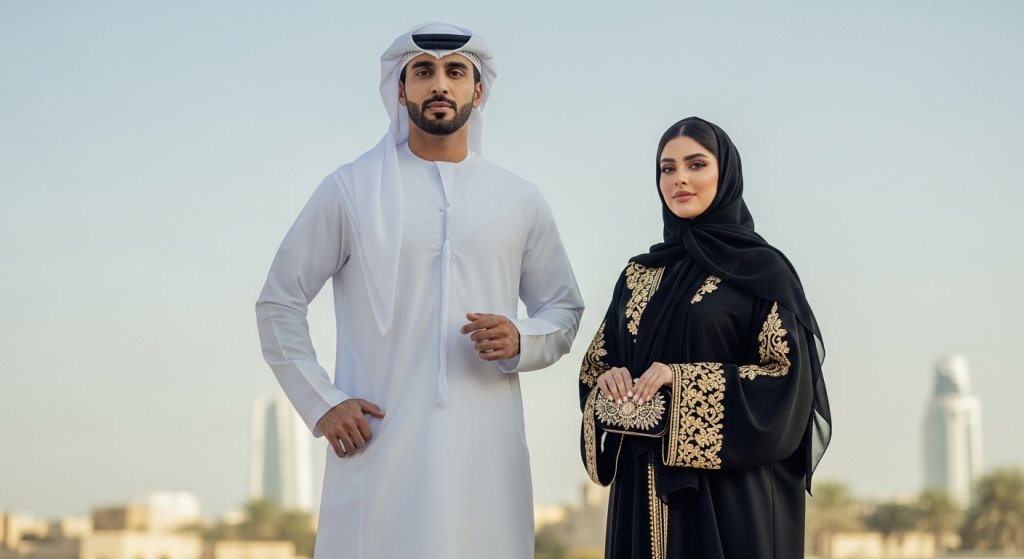The UAE’s traditional dress is more than just clothing. It is a powerful expression of Emirati identity, deeply intertwined with the nation’s rich history, cultural values, and Islamic faith. Understanding these garments is essential for anyone delving into Arabic language and culture. It offers a fascinating insight into the heart of the United Arab Emirates.
While the UAE embraces modernity, traditional attire remains a strong symbol of heritage.Emiratis across the nation wear it with pride.This article will explore the key elements of this clothing in Dubai and the wider UAE. We will shed light on the garments worn by both men and women.
The Elegant Attire of Emirati Women
The UAE traditional dress for ladies is characterized by elegance, modesty, and practicality, perfectly suited to the local climate and cultural norms.
- Abaya: The most recognizable garment for Emirati women is the abaya. It is a long, flowing black cloak worn over their regular clothing. This garment covers the entire body, leaving only the face, hands, and feet visible. As an important symbol of modesty, the abaya is often made from lightweight fabrics like crepe or silk. This ensures comfort in the warm weather. While traditionally black, modern abayas are more diverse. They can feature intricate embroidery, embellishments, and come in various colors for special occasions or to reflect personal preference.
- Sheila: Accompanying the abaya is the sheila, a rectangular scarf worn to cover the head and sometimes the neck. Like the abaya, the sheila is typically black but can also come in different colors and fabrics.Emirati women drape it in various stylish ways, reflecting both tradition and contemporary fashion trends.
- Niqab and Burqa: While less common today, some older women may still wear the niqab, a veil that covers the face, leaving only the eyes visible, or the burqa, a face covering with small slits for the eyes. The burqa in the UAE differs from those in other regions and is often a stiff, decorative mask-like covering, particularly prevalent among older generations in certain areas.
- Kaftan and Jalabiya: For more casual wear within the home or at women-only gatherings, Emirati women often wear the kaftan or jalabiya. These are loose-fitting, often brightly colored and heavily embroidered dresses that are both comfortable and beautiful. The kaftan tends to be more ornate and is often worn for special occasions, while the jalabiya is lighter and more practical for everyday wear.
The Distinguished Dress of Emirati Men
The traditional dress of uae male is equally distinctive and reflects the region’s climate and cultural values.
- Kandura: The cornerstone of men’s traditional clothing is the kandura (also known as thobe or dishdasha). This is an ankle-length, loose-fitting robe typically made of white cotton, ideal for the hot climate. During cooler months, men may opt for kanduras in darker shades like beige, grey, or navy. The simplicity of the kandura reflects a sense of practicality and tradition. A distinguishing feature is the long, loose tassel (tarboucha or farukhah) that hangs from the neckline, which sometimes carries a subtle fragrance.
- Ghutra: The traditional headdress worn by Emirati men is the ghutra. This is a square piece of cotton cloth that is folded and draped in various styles over the head. The most common colors are white, or white with a red and white checkered pattern (known as shemagh, though this term is more prevalent in other Arab countries). The ghutra serves to protect the head from the sun, dust, and wind.
- Agal: To keep the ghutra in place, men wear a black cord called an agal (also known as an igal or oqal) looped around the head.The agal is a sign of manhood and tradition, and how a man wears it can sometimes indicate his tribal affiliation or personal style.
- Ghafiyah: Underneath the ghutra, men often wear a small, embroidered cap called a ghafiyah. This cotton cap helps to keep the ghutra from slipping and adds a layer of comfort. While usually hidden from view, the ghafiyah can feature intricate designs that reflect personal taste.
Ultimately, traditional Emirati clothing serves as a powerful emblem of the nation’s identity. It masterfully blends a deep respect for Bedouin heritage and Islamic modesty with subtle modern evolutions. More than just attire, it is a visible expression of the UAE’s history, values, and enduring cultural pride.
Ready to explore more about the Arabic language and culture? Download the Kaleela App today and embark on a fascinating journey of discovery!



